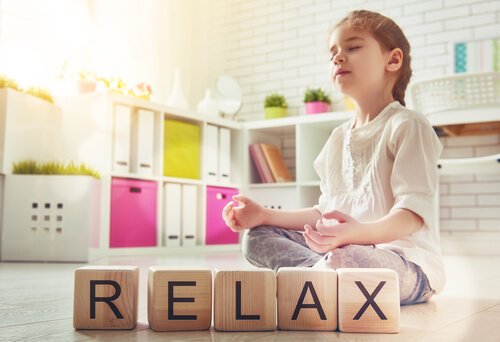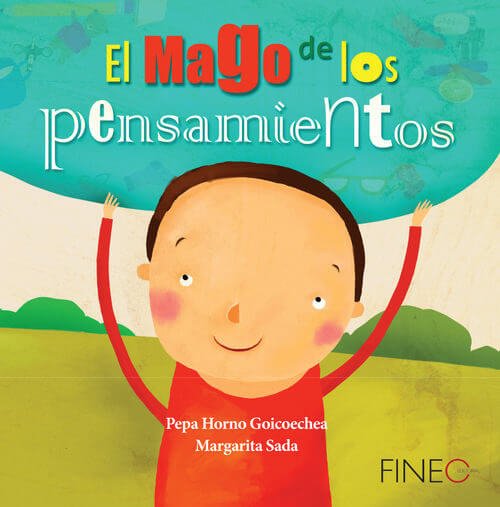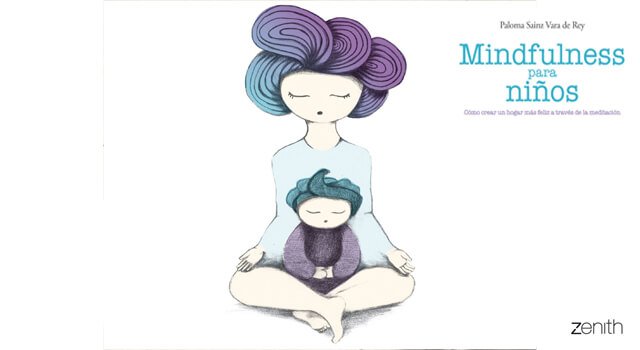5 Books for Practicing Mindfulness in the Classroom

The practice of mindfulness isn’t just limited to adults. School children of all ages can also practice mindfulness in the classroom. Practicing mindfulness can be very beneficial during childhood. Therefore, we’ve decided to dedicate an entire article to the subject.
Mindfulness has its origin in Buddhism, but people all around the world practice it without any religious connotations. This secular idea of mindfulness has certainly helped it spread so widely. People are more open to it because at the root of mindfulness there is, perhaps, more than a question of faith.
“The essence of mindfulness is something absolutely universal that has more to do with the nature of the human mind than with any ideology, belief, or culture. It is more closely related to the ability of knowing and learning than with a religion, philosophy, or concrete point of view.” [translation]
-Kabat-Zinn-
What is mindfulness?
Mindfulness is awareness. Mindfulness is an awareness that develops by paying concrete, sustained, deliberate, and judgment-free attention to the present moment. Be careful not to confuse mindfulness with meditation, as they are not the same.
Mindfulness does not require the rigorous concentration of meditation. You can use mindfulness in any day-to-day activity. Despite their differences, however, the main components of both meditation and mindfulness are concentration and mindful attention.

Why should we teach mindfulness in the classroom?
Mindfulness is a response to the urgent need to find peace. We live in a demanding world. Consequently, we need to make space for finding physical and mental peace. Practicing mindfulness in the classroom can help children find that peace and tranquility.
Children live in a rushed, automated world. They are overstimulated and they are constantly receiving new information. Unfortunately, no one teaches them how to be relaxed, how to live in the present. No one takes the time to instruct them on how to control their body and emotions.
Contrary to what you might believe, children have a great ability to live in the present moment. They can be present without thinking about yesterday or tomorrow. With this innate ability, children easily adapt to mindfulness and there are many authors who highlight its effectiveness.
“If we teach children to live in a more conscious way from an early age, we are helping to raise more free and responsible people who are more able to control their lives, and, undoubtedly, be happier.”
-Arguis-
5 books for practicing mindfulness in the classroom
Next, we will share a series of very useful books for practicing mindfulness in the classroom. As we have seen, mindfulness has many benefits for children. Let’s see what these books are all about.
Emotional Well-Being and Mindfulness in Education
This is a book that offers a complete set of knowledge, methods, tools, and options for educators. These tools are useful for implementing emotional well-being programs, but also to evaluate them and adapt them to any situation.
This book is highly relevant for anyone interested in improving the education system. It’s perfect for teachers, educational administrators, lawmakers, parents, and even the students themselves.
Publisher: Alianza Ensayo
Authors: Javier Garcia-Campayo, Marcelo Demarzo, and Marta Modrego Alarcon
The Wizard of Thought
A great book can be the key to open up a whole new world in children’s development. These kinds of books offer them accurate information as well as a hefty dose of fun. This is exactly what you get with The Wizard of Thought, by Spanish author Pepa Horno Goicoechea.
This book is perfect for any age group. The author encourages us to help our children learn to manage their thoughts and ideas from a young age. She also believes that children should learn to enjoy silence. She argues that silence helps them connect with their inner voice and learn to manage the magic of their souls.
Publisher: Fineo
Author: Pepa Horno Goicoechea

Mindful Education: Cultivating Well-Being in Teachers and Students
There is a new educational paradigm that seeks to cultivate attention, compassion, and well-being. Many teachers are looking for new ways to help their students pay more attention, learn better, and improve themselves every day.
This book is full of educational activities, exercises, and reflections targeted at specific age groups. There is also information for students with special needs. This manual shows the importance of practicing mindfulness in the classroom.
Publisher: Gaia
Author: Daniel J. Rechtschaffe
A Peaceful Forest: Mindfulness for Children
This book explains mindfulness in a simple way. Here, children as young as 4 can start to learn about mindfulness and how to introduce it in their lives. The story is about a fairy telling the animals of the forest how they can deal with their emotions. She explains how to be happy in a world that’s overstimulating.
Her exercises and advice help us direct our little ones on the path of mindfulness. We can easily and happily achieve that objective with them. All it takes is play and enjoyment.
Publisher: Gaia
Author: Ediciones Libreria Argentina (ELA)
Mindfulness for Children
Mindfulness for Children is designed to familiarize children and their parents with meditation. The goal is to help families put meditation into practice every day. Through very simple exercises and daily practice, you will learn to connect with your body. The book guides you to practice mindfulness and distance yourself from your thoughts and emotions.
That way, with a clear mind and an open heart, you will improve your capacity for empathy and compassion. You will also improve your concentration. This practice helps you see things clearly and make better choices for a more authentic life.
Publisher: Zenith
Author: Paloma Sainz Martinez Vara de Rey

In conclusion, these five books are practical and powerful tools. They are great resources for practicing mindfulness in the classroom. We recommend that you read them and put them into practice with all the little ones in your life. They will thank you for it!
The practice of mindfulness isn’t just limited to adults. School children of all ages can also practice mindfulness in the classroom. Practicing mindfulness can be very beneficial during childhood. Therefore, we’ve decided to dedicate an entire article to the subject.
Mindfulness has its origin in Buddhism, but people all around the world practice it without any religious connotations. This secular idea of mindfulness has certainly helped it spread so widely. People are more open to it because at the root of mindfulness there is, perhaps, more than a question of faith.
“The essence of mindfulness is something absolutely universal that has more to do with the nature of the human mind than with any ideology, belief, or culture. It is more closely related to the ability of knowing and learning than with a religion, philosophy, or concrete point of view.” [translation]
-Kabat-Zinn-
What is mindfulness?
Mindfulness is awareness. Mindfulness is an awareness that develops by paying concrete, sustained, deliberate, and judgment-free attention to the present moment. Be careful not to confuse mindfulness with meditation, as they are not the same.
Mindfulness does not require the rigorous concentration of meditation. You can use mindfulness in any day-to-day activity. Despite their differences, however, the main components of both meditation and mindfulness are concentration and mindful attention.

Why should we teach mindfulness in the classroom?
Mindfulness is a response to the urgent need to find peace. We live in a demanding world. Consequently, we need to make space for finding physical and mental peace. Practicing mindfulness in the classroom can help children find that peace and tranquility.
Children live in a rushed, automated world. They are overstimulated and they are constantly receiving new information. Unfortunately, no one teaches them how to be relaxed, how to live in the present. No one takes the time to instruct them on how to control their body and emotions.
Contrary to what you might believe, children have a great ability to live in the present moment. They can be present without thinking about yesterday or tomorrow. With this innate ability, children easily adapt to mindfulness and there are many authors who highlight its effectiveness.
“If we teach children to live in a more conscious way from an early age, we are helping to raise more free and responsible people who are more able to control their lives, and, undoubtedly, be happier.”
-Arguis-
5 books for practicing mindfulness in the classroom
Next, we will share a series of very useful books for practicing mindfulness in the classroom. As we have seen, mindfulness has many benefits for children. Let’s see what these books are all about.
Emotional Well-Being and Mindfulness in Education
This is a book that offers a complete set of knowledge, methods, tools, and options for educators. These tools are useful for implementing emotional well-being programs, but also to evaluate them and adapt them to any situation.
This book is highly relevant for anyone interested in improving the education system. It’s perfect for teachers, educational administrators, lawmakers, parents, and even the students themselves.
Publisher: Alianza Ensayo
Authors: Javier Garcia-Campayo, Marcelo Demarzo, and Marta Modrego Alarcon
The Wizard of Thought
A great book can be the key to open up a whole new world in children’s development. These kinds of books offer them accurate information as well as a hefty dose of fun. This is exactly what you get with The Wizard of Thought, by Spanish author Pepa Horno Goicoechea.
This book is perfect for any age group. The author encourages us to help our children learn to manage their thoughts and ideas from a young age. She also believes that children should learn to enjoy silence. She argues that silence helps them connect with their inner voice and learn to manage the magic of their souls.
Publisher: Fineo
Author: Pepa Horno Goicoechea

Mindful Education: Cultivating Well-Being in Teachers and Students
There is a new educational paradigm that seeks to cultivate attention, compassion, and well-being. Many teachers are looking for new ways to help their students pay more attention, learn better, and improve themselves every day.
This book is full of educational activities, exercises, and reflections targeted at specific age groups. There is also information for students with special needs. This manual shows the importance of practicing mindfulness in the classroom.
Publisher: Gaia
Author: Daniel J. Rechtschaffe
A Peaceful Forest: Mindfulness for Children
This book explains mindfulness in a simple way. Here, children as young as 4 can start to learn about mindfulness and how to introduce it in their lives. The story is about a fairy telling the animals of the forest how they can deal with their emotions. She explains how to be happy in a world that’s overstimulating.
Her exercises and advice help us direct our little ones on the path of mindfulness. We can easily and happily achieve that objective with them. All it takes is play and enjoyment.
Publisher: Gaia
Author: Ediciones Libreria Argentina (ELA)
Mindfulness for Children
Mindfulness for Children is designed to familiarize children and their parents with meditation. The goal is to help families put meditation into practice every day. Through very simple exercises and daily practice, you will learn to connect with your body. The book guides you to practice mindfulness and distance yourself from your thoughts and emotions.
That way, with a clear mind and an open heart, you will improve your capacity for empathy and compassion. You will also improve your concentration. This practice helps you see things clearly and make better choices for a more authentic life.
Publisher: Zenith
Author: Paloma Sainz Martinez Vara de Rey

In conclusion, these five books are practical and powerful tools. They are great resources for practicing mindfulness in the classroom. We recommend that you read them and put them into practice with all the little ones in your life. They will thank you for it!
This text is provided for informational purposes only and does not replace consultation with a professional. If in doubt, consult your specialist.







